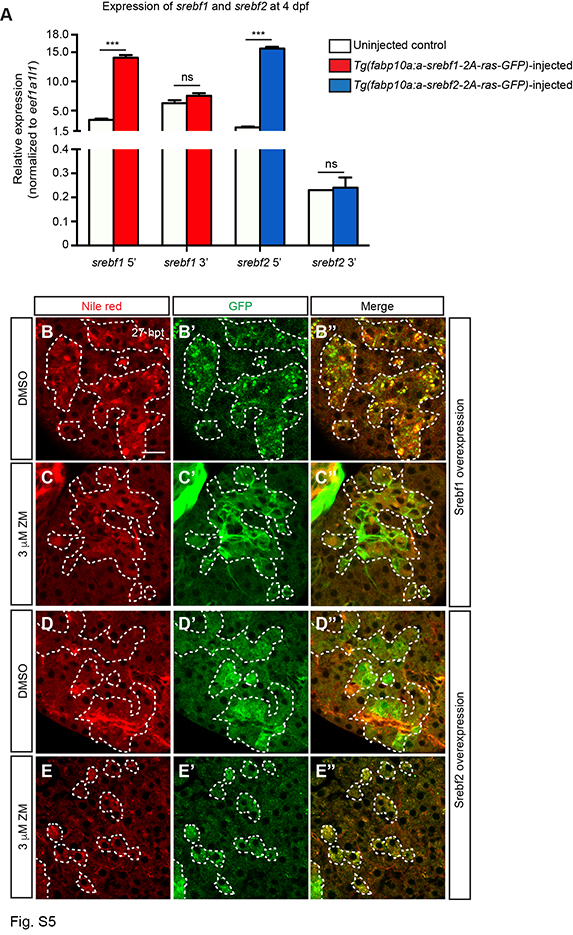Fig. S5
VEGFR inhibition did not suppress the accumulation of lipids that was induced by Srebf1 and Srebf2 overexpression. (A) qPCR analyses showing the hepatic expression of Srebf1 and Srebf2 in the livers from animals injected with active Srebf1 or 2 constructs, and from the uninjected controls. We designed two sets of PCR primers. srebf1 5' and srebf2 5' primers recognize sequences near the 5' end of the open reading frame of the corresponding genes, thus targeting both the mRNAs encoding the active forms of Srebf1 and Srebf2, and the endogenous srebf1 and srebf2 mRNAs, respectively. srebf1 3' and srebf2 3' primers recognize sequences near the 3' end of the open reading frame, thus are specific for the endogenous srebf1 and srebf2 mRNAs. The expression levels of the endogenous srebf1 and srebf2 mRNAs are comparable between uninjected control and injected animals. By contrast, the livers from the injected animals showed significantly higher expression of srebf1 5' and srebf2 5' sequences than the livers from the uninjected control, indicating that they overexpressed the transgene containing the coding sequence for the active form of either protein. Triplicates were performed. The results are represented as relative expression levels that are normalized to the house keeping gene eef1a1l1 (meanąs.e.m.). Statistical significance was calculated by one-way ANOVA and Tukey's post-hoc test. ***, p<0.001; ns, not significant. (B-E'') Confocal single plane images showing Nile red staining for lipid droplets (B-E), GFP for visualizing hepatocytes that had incorporated the transgene (B'-E'), and merged images of the two (B''-E''). Injection of the constructs resulted in mosaic expression of the transgene in the hepatocytes. In DMSO-treated controls (B-B'', D-D''), the hepatocytes that overexpressed active Srebf1 or Srebf2 as indicated by GFP labeling exhibited lipid droplets deposition, whereas the hepatocytes that did not express either transgene and thus were GFP-negative did not contain lipid droplets. Interestingly, the hepatocytes that overexpressed active Srebf1 contained large droplets and the hepatocytes that overexpressed active Srebf2 contained small droplets. Treatment of ZM did not block the formation of lipid droplets caused by Srebf1 or Srebf2 overexpression (C-C'', E-E''). Given that ZM decreased the expression of Srebf2 target genes, our results suggest that Srebf signaling may act downstream of VEGFR to regulate acute ethanol-induced hepatic steatosis. (B-E'') Dashed lines outline the hepatocytes that had incorporated the transgene. Scale bar, 20 ?m. 5 larvae were imaged for each experimental condition.

